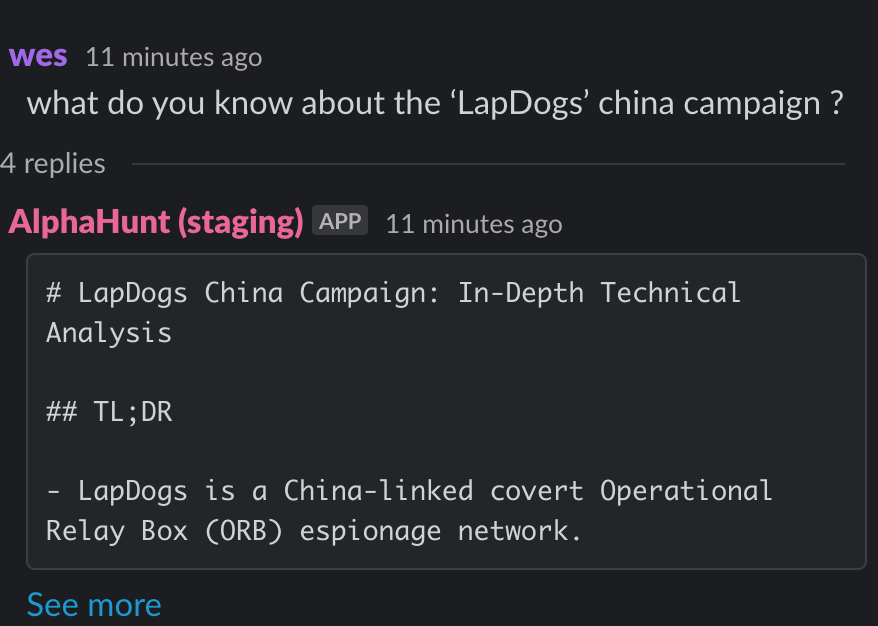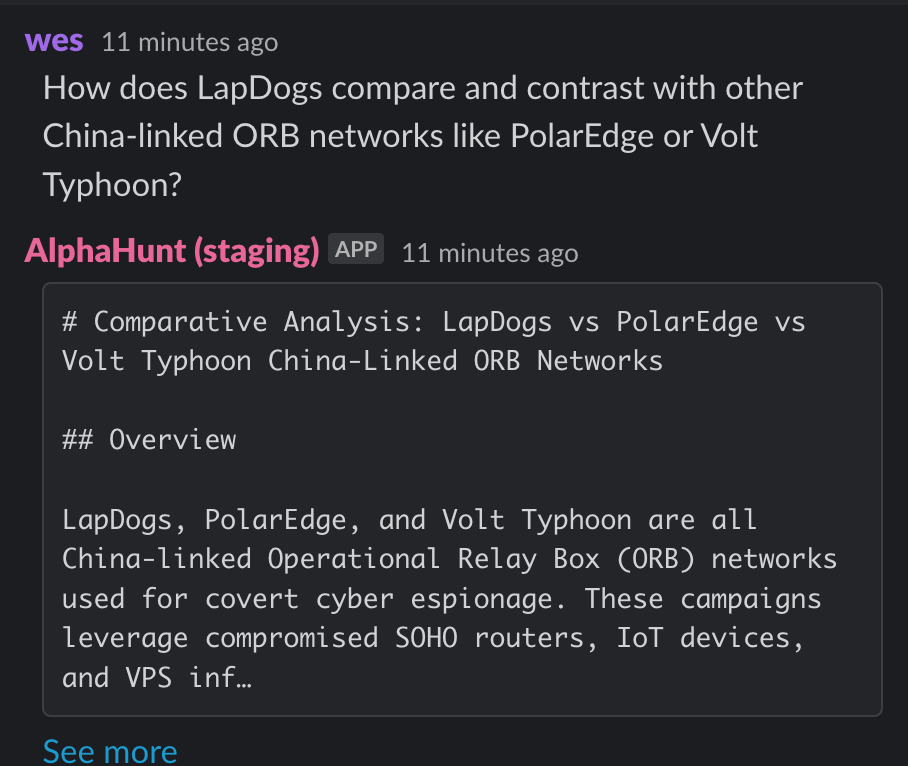LapDogs, PolarEdge, and Volt Typhoon: China-Linked ORB Networks Escalate Espionage Against SOHO and Critical Infrastructure
LapDogs, PolarEdge, and Volt Typhoon represent a new wave of China-linked ORB (Operational Relay Box) networks, each leveraging compromised SOHO routers, IoT devices, and enterprise infrastructure to conduct targeted, persistent espionage. LapDogs, first identified in 2025, uses the "ShortLeash"..



(Have feedback? Did something resonate with you? Did something annoy you? Just hit reply! :))
Have questions like this:
- what do you know about the ‘LapDogs’ china campaign ?
- How does LapDogs compare and contrast with other China-linked ORB networks like PolarEdge or Volt Typhoon?
Does it take a chunks out of your day? Would you like help with the research?
This baseline report was thoughtfully researched and took 10 minutes.. It's meant to be a rough draft for you to enhance with the unique insights that make you an invaluable analyst.
We just did the initial grunt work..
Are you ready to level up your skillset? Get Started Here!
Did this help you? Forward it to a friend!
Suggested Pivot
Which specific Linux-based SOHO device models, firmware versions, and common misconfigurations are most susceptible to LapDogs’ "ShortLeash" backdoor exploitation, and how can targeted detection signatures and mitigation protocols be developed for these high-risk devices to reduce infection rates?
TL;DR
Key Points
-
- Three China-linked ORB (Operational Relay Box) networks—LapDogs, PolarEdge, and Volt Typhoon—are conducting sophisticated, persistent espionage campaigns targeting SOHO devices, critical infrastructure, and enterprise networks, primarily in the US, Taiwan, and Southeast Asia.
- Defenders must prioritize patching, network segmentation, and TLS anomaly detection to disrupt these campaigns.
-
- LapDogs leverages a custom backdoor ("ShortLeash") with unique self-signed TLS certificates mimicking LAPD metadata, focusing on Linux-based SOHO devices (notably Ruckus and Buffalo routers).
- Detection hinges on monitoring for LAPD-like certificates, systemd service file anomalies, and high-port TLS traffic.
-
- PolarEdge exploits CVE-2023-20118 in routers/IoT devices, deploying a "cipher_log" TLS backdoor with consistent PolarSSL-branded certificates, forming a botnet of 2,000+ devices.
- Defenders should monitor for PolarSSL certificates, replaced CGI scripts, and firmware integrity issues on Cisco, Asus, QNAP, and Synology devices.
-
- Volt Typhoon employs living-off-the-land techniques and ORB networks for stealthy, persistent access to critical infrastructure, using Unix shell commands and systemd modifications.
- Behavioral analytics and EDR solutions are essential for detecting these low-noise, high-impact intrusions.
-
- All three groups are evolving TTPs, complicating attribution and detection, and aligning with China’s strategic intelligence objectives.
- Cross-sector intelligence sharing, technical training, and automated detection/response are critical for long-term resilience.
Executive Summary
LapDogs, PolarEdge, and Volt Typhoon represent a new wave of China-linked ORB (Operational Relay Box) networks, each leveraging compromised SOHO routers, IoT devices, and enterprise infrastructure to conduct targeted, persistent espionage. LapDogs, first identified in 2025, uses the "ShortLeash" backdoor and unique self-signed TLS certificates mimicking LAPD metadata to maintain covert C2 and persistence on Linux-based SOHO devices, with a focus on the US and Southeast Asia. PolarEdge, active since late 2023, exploits CVE-2023-20118 and similar vulnerabilities in routers and NAS devices, deploying a "cipher_log" TLS backdoor and forming a global botnet with consistent PolarSSL-branded certificates. Volt Typhoon, known for targeting critical infrastructure, employs living-off-the-land tactics and ORB networks to evade detection and maintain long-term access.
These campaigns are highly targeted, goal-oriented, and align with China’s geopolitical intelligence objectives, focusing on critical infrastructure, government, defense, and technology sectors. Attackers use advanced persistence mechanisms (systemd service files, CGI script replacement), encrypted C2 channels with unique or uniform TLS certificates, and stealthy execution techniques to evade traditional defenses.
Mitigation requires a multi-layered approach: aggressive patch management (especially for SOHO/IoT devices), network segmentation, deployment of IPS with TLS anomaly detection, and advanced EDR/behavioral analytics. Cross-sector threat intelligence sharing and specialized technical training are essential to keep pace with evolving TTPs. In the short term, defenders should focus on detecting unique TLS certificate patterns, monitoring for systemd and CGI script anomalies, and isolating vulnerable devices. Long-term, expect further evolution in ORB network sophistication, targeting of emerging technologies (5G, edge computing), and increased regulatory pressure on IoT security.
The threat landscape is dynamic and complex, with LapDogs, PolarEdge, and Volt Typhoon exemplifying the technical and operational advancements in China-linked cyber espionage. Proactive, intelligence-driven defense is required to mitigate risk and protect critical assets.
Research & Attribution
Historical Context
LapDogs is a newly identified China-linked Operational Relay Box (ORB) network discovered in 2025, primarily targeting Linux-based Small Office/Home Office (SOHO) devices globally, with a focus on the United States and Southeast Asia. It uses a custom backdoor named "ShortLeash" that generates unique self-signed TLS certificates mimicking LAPD metadata to maintain covert control and persistence. LapDogs operates methodically with small-scale, prolonged intrusion sets, indicating a goal-oriented espionage campaign rather than opportunistic botnet activity.
PolarEdge, active since late 2023, is a China-linked IoT ORB network exploiting vulnerabilities such as CVE-2023-20118 in routers and IoT devices. It deploys a TLS backdoor called "cipher_log," uses consistent PolarSSL-branded TLS certificates, and operates a botnet of over 2,000 infected devices globally, targeting vendors like Cisco, Asus, QNAP, and Synology.
Volt Typhoon (also known as Salt Typhoon) is a China-linked threat actor known for building ORB networks targeting critical infrastructure and enterprise networks, including Juniper routers. It employs living-off-the-land tactics and ORB networks to maintain stealthy, persistent access.
Timeline
- Late 2023:
- PolarEdge activity begins targeting IoT and router devices.
- Earliest LapDogs node certificate issued.
- 2024: Volt Typhoon continues espionage campaigns, rebuilding botnets and targeting critical infrastructure.
- Early 2025: LapDogs identified and reported, with detailed analysis published in June 2025.
Origin
All three groups are attributed to China-linked threat actors based on malware analysis, infrastructure overlaps, targeting patterns, and developer artifacts (e.g., Mandarin notes in LapDogs). LapDogs appears to be linked to the UAT-5918 espionage actor targeting Taiwan's critical infrastructure. PolarEdge and Volt Typhoon are part of the broader China-Nexus espionage landscape.
Countries Targeted
- United States – Primary target for LapDogs and PolarEdge, focusing on SOHO devices and critical infrastructure.
- Taiwan – Targeted by LapDogs-linked UAT-5918 and PolarEdge for critical infrastructure espionage.
- Southeast Asia (Japan, South Korea, Hong Kong) – Targeted by LapDogs and PolarEdge.
- Latin America and South America – Noted in PolarEdge botnet infections.
- Canada and other Western countries – Targeted by Volt Typhoon in critical infrastructure sectors.
Sectors Targeted
- Critical Infrastructure – Targeted by LapDogs (via UAT-5918) and Volt Typhoon, including telecommunications and energy.
- Small Office/Home Office (SOHO) Devices – Targeted by LapDogs and PolarEdge to establish ORB networks.
- Government and Defense – Targeted by Volt Typhoon and LapDogs for espionage.
- Technology and Telecommunications – Targeted by PolarEdge and Volt Typhoon.
- Enterprise Networks – Targeted by Volt Typhoon for long-term access and data exfiltration.
Motivation
Espionage is the primary motivation, focusing on long-term surveillance, data theft, and persistent access to strategic targets aligned with China’s geopolitical objectives. The campaigns aim to gather intelligence on US and allied critical infrastructure, government, and technology sectors.
Attack Types
- Exploitation of vulnerabilities in routers and IoT devices (e.g., CVE-2023-20118).
- Deployment of custom backdoors: LapDogs uses "ShortLeash" (with unique TLS certs), PolarEdge uses "cipher_log" TLS backdoor.
- Use of ORB networks composed of compromised devices and VPS nodes to obfuscate command and control (C2) traffic.
- Persistence via systemd service files (LapDogs) and CGI script replacement (PolarEdge).
- Use of unique or consistent self-signed TLS certificates to masquerade as legitimate services.
- Living-off-the-land techniques (Volt Typhoon) to evade detection.
- Methodical, small-scale, task-driven intrusion campaigns.
Known Aliases
- LapDogs (SecurityScorecard STRIKE Team)
- UAT-5918 (Cisco Talos) – linked to LapDogs
- ShortLeash (custom backdoor used by LapDogs)
- PolarEdge (Sekoia)
- Volt Typhoon
Links to Other APT Groups
LapDogs is linked to UAT-5918, a China-Nexus espionage actor. Volt Typhoon is somewhat associated (?) with Salt Typhoon (MITRE G1045) and other China-Nexus groups. PolarEdge shares infrastructure characteristics with LapDogs but is a distinct ORB network.
Similar Threat Actor Groups
LapDogs, PolarEdge, and Volt Typhoon are China-linked ORB networks used for espionage. They share tactics such as leveraging compromised edge devices for covert C2 but differ in malware payloads, persistence mechanisms, and TLS certificate management.
Breaches Involving This Threat Actor
LapDogs has infected over 1,000 SOHO devices globally, with targeted espionage on US and Southeast Asian networks. Volt Typhoon has been linked to breaches in critical infrastructure sectors, including telecommunications in North America. PolarEdge has compromised thousands of IoT devices worldwide, forming a large botnet used for covert operations.
Technical Analyst Highlights
- LapDogs uses MITRE ATT&CK techniques such as T1071.001 (Web Protocols for C2), T1562.001 (Disable or Modify Tools), and T1499 (Endpoint Denial of Service) to establish and maintain ORB networks.
- PolarEdge exploits CVE-2023-20118 (T1190) for initial access and uses a sophisticated TLS backdoor ("cipher_log") for encrypted C2 (T1573.001).
- Volt Typhoon employs living-off-the-land techniques (T1059.004) and reconnaissance (T1591), leveraging ORB networks for stealthy C2.
- Persistence in LapDogs is achieved via systemd service files with root privileges; PolarEdge replaces CGI scripts for persistence.
- LapDogs generates unique self-signed TLS certificates per node mimicking LAPD metadata; PolarEdge uses uniform PolarSSL certificates.
- Infrastructure includes compromised SOHO routers, IoT devices, and VPS nodes, with geographic focus on the US, Southeast Asia, and Taiwan.
- Mitigation strategies include patching vulnerable devices (M1036), network segmentation (M1040), and network intrusion prevention (M1037).
Geopolitical Context and Implications
These ORB campaigns represent a sophisticated evolution in China’s cyber espionage capabilities, enabling stealthy, persistent access to critical infrastructure and strategic sectors in the US and allied countries. The use of ORB networks complicates attribution and detection, raising the cost and complexity of defense for US national security. The campaigns align with China’s broader intelligence objectives to gather economic, political, and military intelligence. US government agencies, including CISA and FBI, have issued advisories urging enhanced monitoring and patching of vulnerable edge devices to mitigate these threats.
This detailed comparative analysis provides technical depth, validated references from authoritative sources, and expanded geopolitical context tailored for a technical analyst audience.
Recommendations, Actions, Suggested Pivots, Forecasts and Next Steps
(Subscribers Only)


![[DEEP RESEARCH] Zero-Days Are a Distraction: 2025’s Biggest Losses Were Stolen Tokens + OAuth](/content/images/size/w600/2025/12/zz-3.png)


